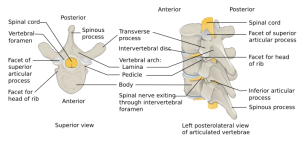Cervical injury (peds): Difference between revisions
Kurtucla05 (talk | contribs) |
No edit summary |
||
| (22 intermediate revisions by 7 users not shown) | |||
| Line 1: | Line 1: | ||
{{Peds top}} [[cervical spine injury]] | |||
==Background== | ==Background== | ||
C-spine injury uncommon in children but large head in age <8 | *C-spine injury uncommon in children but large head in age <8 creates system for upper cervical injury | ||
*Injuries most feared include [[atlanto-occipital dissociation]] (AOD) and atlantoaxial rotatory subluxation or fixation (AARF). | |||
===SCIWORA=== | |||
*Spinal cord injury without radiographic abnormality | |||
*Exam findings of myelopathy without abnormalities on XR or CT | |||
==Clinical Features== | ==Clinical Features== | ||
*Blunt trauma in pediatric population. | *[[blunt neck trauma|Blunt trauma]] in pediatric population. | ||
*AARF- may occur spontaneously or in trauma- exam shows head rotated, tilted or unable to turn past midline | *AARF- may occur spontaneously or in trauma- exam shows head rotated, tilted or unable to turn past midline | ||
*AOD- can be devastating injury or even fatal | |||
== | ==Differential Diagnosis== | ||
{{Cervical spine injuries}} | |||
==Evaluation== | |||
[[File:Pediatric cspine.png|thumb|Algorithm for the evaluation of pediatric cervical spine injuries]] | |||
===C-Spine Clearance Without Imaging=== | |||
====<3 years old==== | |||
*[[GCS (Peds)|GCS]]>13 | |||
*no neurological deficit | |||
*no midline cervical tenderness to palpation | |||
*no painful distracting injury | |||
*no unexplained hypotension | |||
*not intoxicated | |||
*mechanism-image if: MVC, fall >10 feet, non-accidental trauma known or suspected | |||
== | ====>3 years old==== | ||
* | *alert | ||
* | *no neurological deficit | ||
*no midline cervical ttp | |||
*no painful distracting injury | |||
*no unexplained hypotension | |||
*not intoxicated | |||
== | ===Imaging=== | ||
''No imaging if above criteria met based upon age'' | |||
*CT c-spine for concern of Atlanto-occipital dislocation(AOD) or atlantoaxial rotatory subluxation or fixation (AARF) | *CT c-spine for concern of Atlanto-occipital dislocation(AOD) or atlantoaxial rotatory subluxation or fixation (AARF) | ||
#AOD- CT to look for condyle-C1 interval (CCI) | |||
*SCIWORA- full spinal column | #AARF- C1-C2 motion analysis to characterize injury(3 position CT) | ||
#Plain films otherwise acceptable | |||
*SCIWORA- full spinal column radiographic imaging | |||
**MRI of suspected area of spinal damage | **MRI of suspected area of spinal damage | ||
**Assess spinal stability acutely and in follow-up with flex/ex films | **Assess spinal stability acutely and in follow-up with flex/ex films | ||
| Line 38: | Line 48: | ||
==Management== | ==Management== | ||
*Immobilization must account for relatively larger occiput using occipital recess or thoracic elevation to maintain c-spine neutrality. | *Immobilization must account for relatively larger occiput using occipital recess or thoracic elevation to maintain c-spine neutrality. | ||
*Neurosurgery consult for abnormalities | |||
==See Also== | ==See Also== | ||
{{Head Trauma Links Template}} | |||
== | ==References== | ||
*EB Medicine- EM Practice Guideline Update- Sept 2014- Updated Guidelines For Management Of Acute Cervical Spine And Spinal Cord Injury In Pediatric Patients | *EB Medicine- EM Practice Guideline Update- Sept 2014- Updated Guidelines For Management Of Acute Cervical Spine And Spinal Cord Injury In Pediatric Patients | ||
*American Association of Neurological Surgeons and Congress of Neurological Surgeons in 2013. | |||
[[Category:Pediatrics]] | |||
[[Category:Trauma]] | |||
[[Category:Neurology]] | |||
Latest revision as of 22:52, 28 November 2019
This page is for pediatric patients. For adult patients, see: cervical spine injury
Background
- C-spine injury uncommon in children but large head in age <8 creates system for upper cervical injury
- Injuries most feared include atlanto-occipital dissociation (AOD) and atlantoaxial rotatory subluxation or fixation (AARF).
SCIWORA
- Spinal cord injury without radiographic abnormality
- Exam findings of myelopathy without abnormalities on XR or CT
Clinical Features
- Blunt trauma in pediatric population.
- AARF- may occur spontaneously or in trauma- exam shows head rotated, tilted or unable to turn past midline
- AOD- can be devastating injury or even fatal
Differential Diagnosis
Vertebral fractures and dislocations types
- Cervical fractures and dislocations
- Thoracic and lumbar fractures and dislocations
Evaluation
C-Spine Clearance Without Imaging
<3 years old
- GCS>13
- no neurological deficit
- no midline cervical tenderness to palpation
- no painful distracting injury
- no unexplained hypotension
- not intoxicated
- mechanism-image if: MVC, fall >10 feet, non-accidental trauma known or suspected
>3 years old
- alert
- no neurological deficit
- no midline cervical ttp
- no painful distracting injury
- no unexplained hypotension
- not intoxicated
Imaging
No imaging if above criteria met based upon age
- CT c-spine for concern of Atlanto-occipital dislocation(AOD) or atlantoaxial rotatory subluxation or fixation (AARF)
- AOD- CT to look for condyle-C1 interval (CCI)
- AARF- C1-C2 motion analysis to characterize injury(3 position CT)
- Plain films otherwise acceptable
- SCIWORA- full spinal column radiographic imaging
- MRI of suspected area of spinal damage
- Assess spinal stability acutely and in follow-up with flex/ex films
Management
- Immobilization must account for relatively larger occiput using occipital recess or thoracic elevation to maintain c-spine neutrality.
- Neurosurgery consult for abnormalities
See Also
General/Adult
Pediatric
- C-spine (peds)
- Abuse (Nonaccidental Trauma)
- GCS (Peds)
- EBQ:PECARN Pediatric Head CT Rule
- Differential diagnosis documentation#Head Trauma
References
- EB Medicine- EM Practice Guideline Update- Sept 2014- Updated Guidelines For Management Of Acute Cervical Spine And Spinal Cord Injury In Pediatric Patients
- American Association of Neurological Surgeons and Congress of Neurological Surgeons in 2013.





